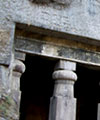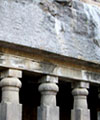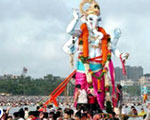|
Aurangabad Sightseeing
[ Daultabad Fort | Khuldabad
| Grishneshwar temple | Bibi
Ka Maqbara | Panchakki | Pariyon
Ka Talab | Paithan | Pithalkora
]
Daulatabad Fort (Distance - 7 km):
Originally the mountainous Deogiri fortress, it was an old Hindu stronghold, finally captured and plundered by falseness in the 13th century. Made the capital of the Delhi Sultanate a 100 years later by Tughlaq, it was the prime fortress of many successive dynasties in the Deccan. Daulatabad is famous for it's series of trick defences, secret escape routes, etc. Important monuments within the fort include the Jami Masjid - now the Bharat Mata Mandir, the Chand Minar, Elephant Tank and Chini Mahal or Chinese Palace.
Rising dramatically over 600 ft above the Deccan plain is the arresting sight of Daulatabad. Once known as Devgiri, this fort served as the head quarters of the powerful Yadava rulers. In the 13th century, Mohammed bin Tughlak, the Sultan of Delhi, made it his capital and renamed it Daulatabad, or City of Fortune.
In the 14th century, several Sufi saints of the Chishti order, chose to reside in Khuldabad or the Abode of Eternity. The dargah, or tomb of Moinuddin Chishti, the spiritual guide of the Mughal emperor, Aurangzeb, is within this sacred complex. The austere emperor himself rests nearby, in a grave as simple as that of a common man's, in striking contrast to the grand mausoleums of his predecessors. Eloquent testimony to Aurangzeb's simplicity is the inscription on his plain tombstone: "No marble sheets should shield me from the sky as I lie there one with the earth."
Top
Khuldabad (Distance - 14 km):
At the holy village of Khuldabad or Abode of Eternity is located the tomb of the last great Moghul Emperor Aurangzeb. His simple tomb remains an eloquent testament to the staunch faith and spartan lifestyle of this pious Muslim ruler. As per his instructions, the tomb was built only with the few rupees he had earned by stitching cloth caps! On his tombstone is inscribed in elegant Persian calligraphy: "No marble sheets should shield me from the sky as I lie there one with the earth."
Getting there:
Khuldabad is a part of the MTDC tour to Ellora. It can also be reached by private taxis.
Top
Ghrishneshwar Temple (Distance - 18 km):
Worshippers of Shiva flock to the Ghrishneshwar Temple, of particular importance since it enshrines a jyotirlinga. This particular aspect of the god's luminous energy is manifested in only 12 temples. Ghrishneshwar was built in the 18th century of spotted red sandstone. Decorative friezes and sculpture depict a pantheon of Indian gods including Bhrama, Vishnu, Ganesh, the marriage of Shiva and Parvati, celestial beings, and even Maratha heroes.
Top
Bibi ka Maqbara (Distance - 6 km):
Built by Azam Shah in 1678, the Bibi ka Maqbara is a son's loving tribute to his mother, Begum Rabia Durrani, the Queen of Mughal emperor Aurangzeb. It is the tomb of Begum Rabia Durani, wife of Emperor Aurangzeb. Due to its similar design, it is popularly known as the mini Taj of the Deccan. Standing spectacularly on the lawns of the landscaped garden with ponds, fountains and water channels, the white marbled monument rises majestically in an intentional bid to copy and rival the world famous Taj Mahal of Agra. Four towering minarets frame the central tomb, distinguished by elaborate surface ornamentation and intricately perforated marble screens. The Maqbara stands in the middle of a spacious and formally planned Mughal garden with axial ponds, fountains, water channels, broad pathways and pavilions. Frequent visitors are flights of chattering parrots (The Maqbara can be viewed from the gardens of The Meadows).
Top
Panchakki (Distance - 4 km):
An intriguing water mill, the Panchakki is famous for its underground water channel, which obstacles more than 8 kms to its source away in the mountains. The channel culminates in a mesmerizing 'artificial' waterfall that powers the mill. The beauty of the mosque housed in the inner enclosure is enhanced by a series of 'dancing' water fountains. An engineering feat of the time is the Panchakki, or the water mill built by Malik Ambar in 1695. The water, channeled from a spring on a distant hill was used to power the flour mill and grind grain for the pilgrims.
Top
Pariyon ka Talab (Distance - 60 km):
Translated to mean 'Fairies' Lake', it is a large lake with steps all along its western shore and a stage like platform which bears great resemblance to the ancient roman amphitheatre. On the banks is also a temple of Shiva with its own colourful history.
Top
Paithan (Distance - 56 km):
The ancient city and pilgrim centre of Paithan is situated on the banks of the Godavari. Today it is famous for the beautiful 'Paithanis' - woven silk sarees with intricate zari borders. A visit to the weavers' workshop is fascinating and you can order a customised saree as well. A trip to the garden at the Jayakwadi dam with its dancing fountains and special observation points for bird watching is also an option.
Paithan is 51 kms south of Aurangabad and the looms of Paithan still weave the beautiful Paithani saris that is dear to all Indian women. The town is also famous for the Dnyaneshwar Udyan, which is the largest garden in Maharashtra, and a museum, which treasures a fascinating collection of art. The Jaikwadi Dam nearby is a bird-watchers delight.
Getting there:
There a number of states transport buses that leave at regular intervals for Paithan from Aurangabad. In addition cars or taxis are easily available as well.
Aurangabad is the gateway to the region, and is generally where you would arrive or depart.
Top
Pithalkora (Distance - 78 km):
Located on the ancient trade route, at Pithalkora are 13 cave sanctuaries dating back to the 2nd century B.C., with additions in the 5th and 6th centuries. The relief work in Pithalkora is richer, more elaborate and the carving more precise than at early sites. Thirteen Buddhist excavations, dating from the 2nd century BC to the 1st century AD lie about 40 km northwest of Ellora, cut into the side of an isolated gap. Comprising mainly viharas, they form the largest group of Hinayana Buddhist structures.
The gateway to the World Heritage Sites of Ajanta and Ellora, Aurangabad is named after the Mughal emperor, Aurangzeb. Lying along the Right Bank of the Kham River, the city is the district headquarters, which offers visitors all the modern comforts and amenities. There are several luxury and budget hotels, shopping centres and banks.In the city, there are three museums housing the art treasures of the region -- the Sunheri Mahal Museum, the University Museum and the Chhatrapati Shivaji Museum. You can also while away the hours in the pleasant confines of the Bani Begum Gardens.
Getting there:
Pitalkhora is best accessed by private car or taxi and can be reached from Aurangabad by motoring on the MSH1 and taking the diversion after Satkunda Lonar Crater 170 kms from Aurangabad, is the village of Lonar. Over 30,000 years ago, a falling meteorite struck the area creating the world's largest impact crater in basaltic rock. Botanists have recently discovered vegetation life forms not found anywhere else on this planet, in the stunning lake of the crater.
Darwazas:
Most of the monuments in Aurangabad are of the Nizam Shahi, Mughal and Maratha period. There are four main darwazas, or gates leading into the city, which along with nine secondary darwazas formed part of the defense systems of the city.
Top
General Information & Accomdation info on Aurangabad city of Maharashtra
- India
|






